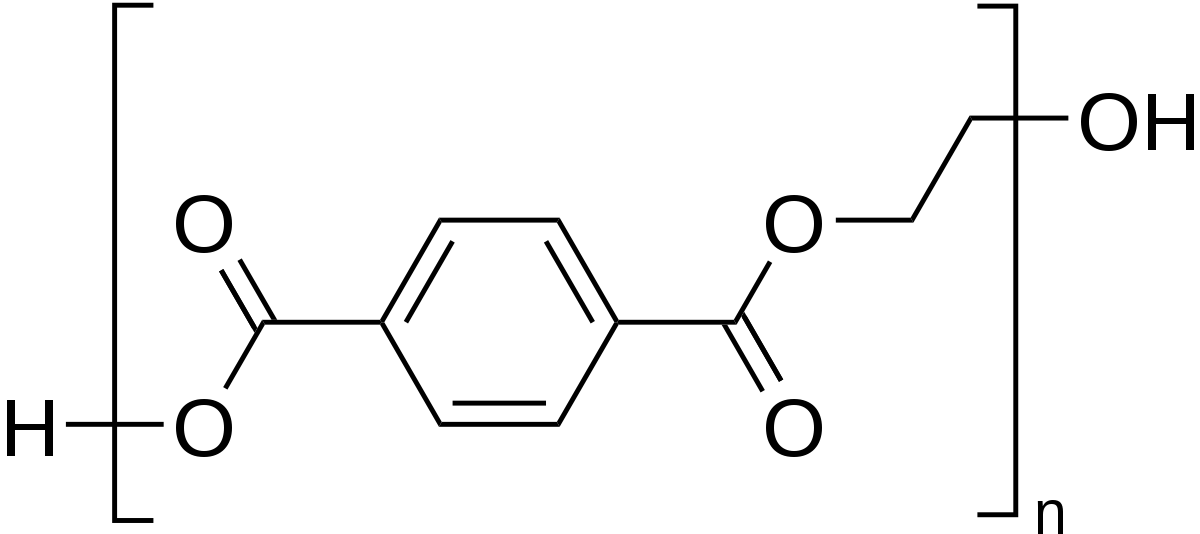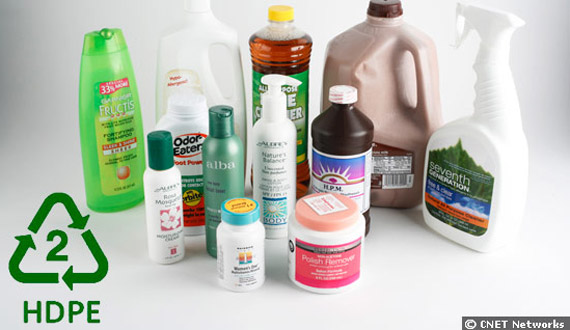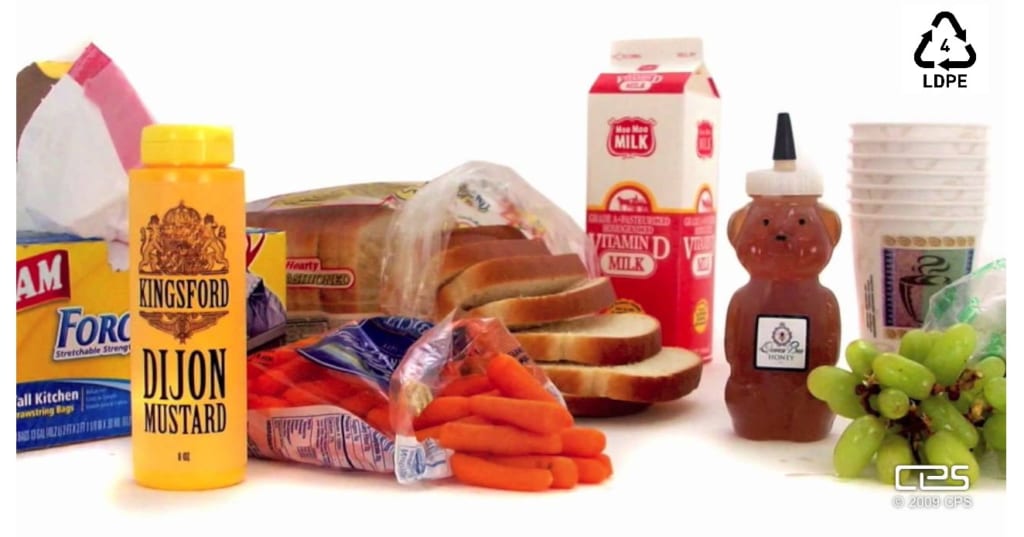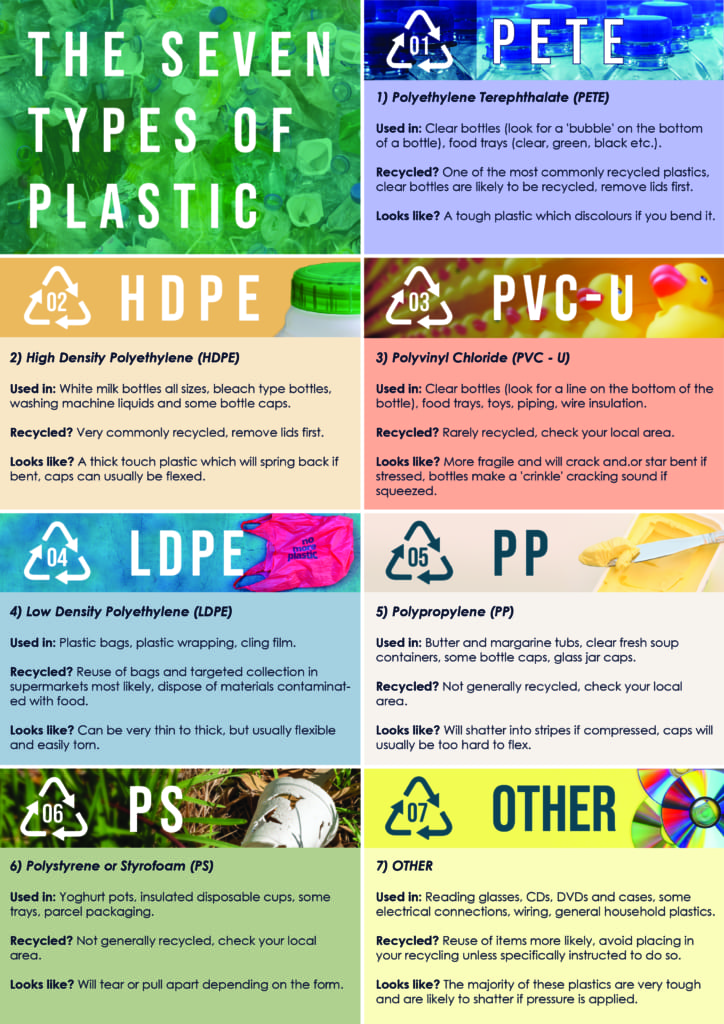Plastic is an essential component of many items, products in our present life. So knowing the difference, as well as the Plastic codes will help you make more informed decisions about recycling. There are Seven Types Of Plastic:


1. Polyethylene Terephthalate (PET or PETE or Polyester)
Polyethylene terephthalate (PET or PETE) is a general-purpose thermoplastic polymer that belongs to the polyester family of polymers. As a result, Polyester resins have some excellent combination of properties such as mechanical, thermal, chemical resistance as well as dimensional stability.
Formula: (C10H8O4)n

Density: 1.38g/cm3
Used: Soda bottles, Water bottles, Salad dressing bottles, Medicine jars, Combs, Bean bags, Rope, Carpet, Fiberfill material in winter clothing, etc, for example
Recyclable: This is one of the most commonly recyclable plastics. Clear bottles are likely to be. recycled, please remove lids first.


2. High-Density Polyethylene (HDPE)
High-Density Poly Ethylene (HDPE) is a thermoplastic polymer made from petroleum. Therefore, HDPE plastic is used in a wide variety of applications such as Garbage Bag, Shopping Bag, Plastic Bottles, etc. Known for its outstanding tensile strength and large strength-to-density ratio, HDPE plastic has a high-impact resistance and melting point as a result.
Formula: (C2H4)n

Density: 0.95g/cm3
Used: Shopping bags, Trash bags, Shampoo and conditioner bottles, Soap bottles, Bleach containers, Toys, etc, for example
Recyclable: Yes, it’s very commonly recycled.
HDPE Plastic bag is one of our strong product. Please kindly check here our products here.



3. Polyvinyl Chloride (PVC – U)
Polyvinyl Chloride (PVC) is one of the most widely used polymers in the world. Due to its versatile nature, PVC is used extensively across a broad range of many industrials as a result.
Formula: (C2H3Cl)n

Density: 1.38g/cm3
Used: Clear bottles (look for a line on the bottom of the bottle), food trays, toys, piping, wire insulation, etc, for example
Recyclable: Rarely recycled so check your local area.


4. Low-Density Polyethylene (LDPE)
As the name suggests, LDPE has a lower “density” than HDPE. That just means it has a bit less mass compared to its volume
Most importantly, LDPE is resistant to impact (doesn’t break easily), moisture (waterproof), and chemical resistance (can stand up to many hazardous materials).
Formula: (C2H4)n

Density: 0.93g/cm3
Used: Plastic bags, Garbage Bag, Shopping Bag, Plastic Wrapping, Cling Film, etc, for example
Recyclable: Yes, very popular.



5. Polypropylene (PP) The Seven Types Of Plastic
Polypropylene has high flexural strength due to its semi-crystalline nature. It has a relatively slippery surface. In addition, Polypropylene is very resistant to absorbing moisture as well as having a good chemical resistance over a wide range of bases and acids.
Formula: (C3H6)n

Density: 0.855g/cm3 – 0.946g/cm3
Used: Mesh Bag, Plastic containers, Reusable water bottles, Medical components, Outdoor furniture, Toys, Luggage, Car parts, etc, for example
Recyclable: Not generally recycled so check your local area.



6. Polystyrene or Styrofoam (PS) The Seven Types Of Plastic
Polystyrene is a synthetic aromatic hydrocarbon polymer which is made from the monomer known as styrene.
PS can be solid or foamed. General-purpose polystyrene is clear, hard, and rather brittle. Furthermore, it is also an inexpensive resin per unit weight. It is a rather poor barrier to oxygen and water vapor and has a relatively low melting point.
Formula: (C8H8)n

Density: 0.96–1.05 g/cm3
Used: Disposable coffee cups, Plastic food boxes, Plastic cutlery, Packing foam, and Packing peanuts, for example
Recycled: Not generally recycled so check your local area


7. OTHER
This is the catch-all category of all other plastics so many biodegradable, photo-sensitive, and plant-based plastics fit in this category. Basically, any plastic that is not HDPE, LDPE, PET, PVC, PS, or PP are put into this category.
Some common plastics you might recognize from this group are: Polycarbonate, Polylactic Acid (PLA), Acrylonitrile Butadiene Styrene (ABS), fiberglass, and nylon, etc, for example.
Used: Plastic CDs and DVDs, Baby bottles, Large water bottles with multiple-gallon capacity, Medical storage containers, Eyeglasses, etc, for example.
Recycled: Depend on what kind, you should avoid placing in your recycling unless specifically instructed to do so.


8. Summary about Seven Types Of Plastic

Contact us
HANPAK JSC
Website: www.hanpak.com.vn
Office: K03-18T2, CT15 Viet Hung Green Park, Giang Bien, Long Bien, Hanoi, Vietnam 100000
Mobile (WhatsApp): +84 898 545 893
Email: info@hanpak.com.vn



